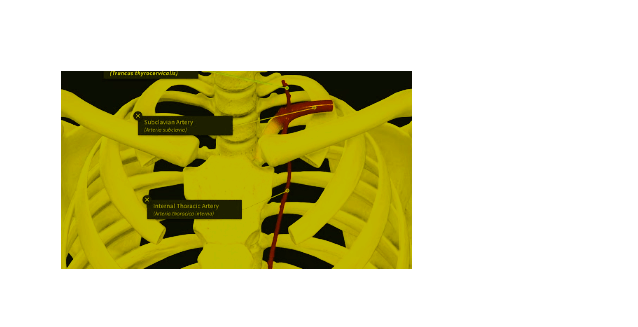Quick Overview
What is internal mammary artery? The internal mammary artery (IMA), also known as internal thoracic artery, is a long, paired vessel that originates from the proximal part of the subclavian artery.
It runs inferomedially and enters the thoracic cage deep to the clavicle and the first rib. The IMA then descends along the inner surface of the anterior chest wall, supplying blood to the breast, sternum, and various intercostal muscles. The IMA terminates at the xiphoid process, by dividing into musculophrenic and the superior epigastric arteries.

Table of Contents
Anatomy:
The IMA is paired, with both right and left branches. It originates from the subclavian artery, descending along the posterior part of the ribcage, and branching into the chest wall and the heart.
| Artery | Description |
| Origin | Proximal part of the subclavian artery. |
| Branches | Perforating branches, Anterior intercostal branches, Musculophrenic artery, Superior epigastric artery |
| Supply | Breast, Sternum, Intercostal muscles, Parietal pleura, Diaphragm, Anterior abdominal wall |
Right Internal Mammary Artery
The right IMA originates from the right subclavian artery. It runs along the inner surface of the right anterior chest wall, and supply blood to the breast, sternum, and intercostal muscles.
The right IMA terminates at the xiphoid process, where it divides into the right musculophrenic and the right superior epigastric arteries.
Left Internal Mammary Artery
The left IMA originates from the left subclavian artery and run along the inner surface of the left anterior chest wall It also supply blood to the breast, sternum, and intercostal muscles. The left IMA terminates at the xiphoid process, where it divides into the left musculophrenic and the left superior epigastric arteries.
Branches
Following branches arises from IMA:
1- Perforating branches: These branches supply blood to the breast and sternum.
2- Anterior intercostal branches: These branches supply blood to the intercostal muscles and the parietal pleura.
3- Musculophrenic artery: This artery supplies blood to the diaphragm and the anterior abdominal wall.
4- Superior epigastric artery: This artery supplies blood to the superior epigastric region of the abdomen.
Supplies
The IMA supplies blood to the following structures:
- Breast
- Sternum
- Intercostal muscles
- Parietal pleura
- Diaphragm
- Anterior abdominal wall
Conditions Associated with IMA
A number of conditions can affect the IMA, including:
- Coronary artery bypass grafting (CABG): The IMA is commonly used as a graft vessel in CABG surgery.
- Internal mammary artery dissection: A dissection of the IMA is a tear in the inner lining of the artery. This can be caused by trauma, infection, or other conditions.
- Internal mammary artery aneurysm: An aneurysm of the IMA is a bulge or weakening in the wall of the artery. This can be caused by high blood pressure, atherosclerosis, or other conditions.
- Internal mammary artery stenosis: A stenosis of the IMA is a narrowing of the artery. This can be caused by a buildup of plaque, which is a fatty substance that can form on the walls of the arteries.
Questions
1. Why is the Internal Mammary Artery used for grafts?
The IMA is favored for grafts in coronary artery bypass surgery due to its durability and long-term success in restoring blood flow to the heart muscle.
2. Where is the Left Internal Mammary Artery located?
The Left Internal Mammary Artery (LIMA) runs parallel to the sternum, supplying the left side of the chest wall and serving as a common graft in heart surgery.
3. What type of graft is the Internal Mammary Artery graft?
The Internal Mammary Artery graft is an arterial graft, often used to bypass blocked coronary arteries and improve blood supply to the heart.
4. What does the Internal Mammary Artery supply?
The Internal Mammary Artery supplies oxygenated blood to the chest muscles, ribs, and diaphragm. It is also used to restore blood flow to the heart muscle in coronary artery bypass grafting.
5. What is also known as the Internal Mammary Artery?
The IMA is also known as the Internal Thoracic Artery. Both terms refer to the same vital blood vessel in the chest.
